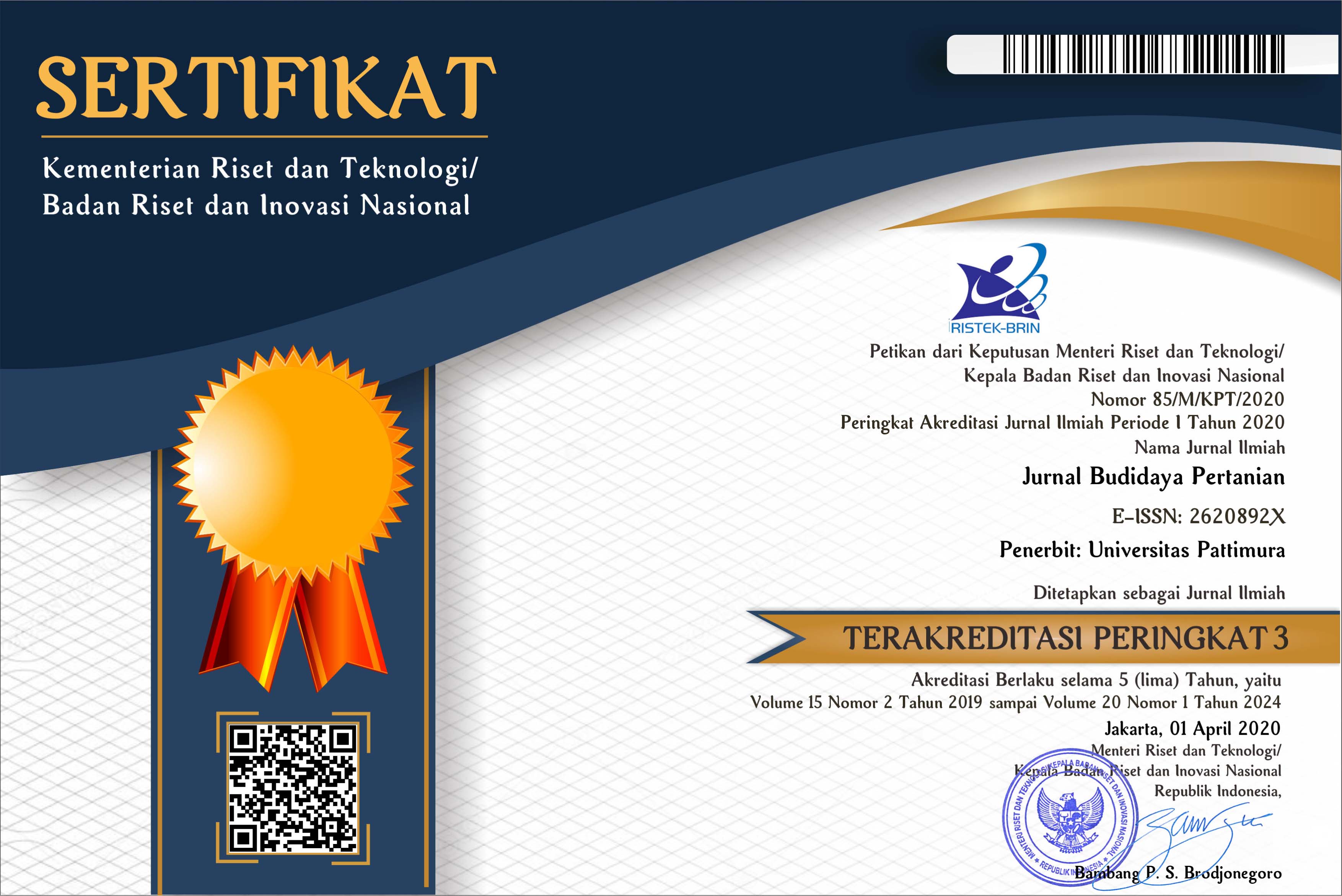Diversity of Macroscopic Fungal Types in South Leitimur District, Ambon City
Abstract
Macroscopic fungi are eukaryotic, heterotrophic, cosmopolitan organisms, have fruit bodies large enough to be seen without using tools, and vary in morphology, size, and color. This research was carried out in two villages in Leitimur Selatan District, Ambon City, namely Hutumuri and Ema, from May 2022 to July 2022. Macroscopic fungal samples were obtained during a survey using the exploration method. Sampling locations were based on predetermined transect lines and random fungal samples were taken at each location. Identification in the laboratory was carried out to determine the type of mushroom, fruit body shape, color, and size of the mushroom. The data obtained was then analyzed qualitatively and quantitatively. The research results obtained 32 species of fungi consisting of two divisions, namely Ascomycota and Basidiomycota, as well as 18 families. The frequency of the presence of fungi in Leitimur Selatan District was the highest at 19.6% and the lowest at 0.1%, and the fungal populations found lived either alone or in colonies. Based on Hierarchical Cluster Analysis (HCA), macroscopic fungi at the research location were divided into two large groups with a dissimilarity coefficient of 31%. The main differentiating character based on Principle Component Analysis (PCA-Biplot) found that the characteristic character in the descriptor of seven fungal species was the lamella character, and the differentiating character in the descriptor of two fungal species was the pore characteristics and pore size.
Downloads
References
Badan Pusat Statistik [BPS]. 2021. Kecamatan Leitimur Selatan Dalam Angka. BPS Kota Ambon.
Campbell, N.A., Reece, J.B., Reece, L.G. Mitchell. 2008. Biologi Edisi 8 Jilid 2. Erlangga, Jakarta. ISBN: 978-979-075-688-5
Desjardin, D.E, M.G. Wood, and F.A. Stevens. 2014. California Mushrooms, The Comprehensive Identification Guide.Timber Press. Portland-London. ISBN 10: 1604693533 ISBN 13: 9781604693539
Dwidjoseputro, D. 1978. Pengantar Mikologi, Edisi Kedua. Penerbit Alumni. Bandung.
Gunawan, A. W. 2001. Usaha Pembibitan Jamur. Penebar Swadaya, Jakarta. ISBN: 979-489-539-3
Hall, I. R., S.L. Stephenson., P.K. Buchanan., W. Yun, & A.L., J. Cole. 2003. Edible and Poisonous Mushrooms of the World.Timber Press. Portland-Cambridge. ISBN:0-88192-586-1
Huffman, D. M., L. Tiffany., G. Knaphus, & R. Healy. 2008. Mushrooms and Other Fungi of the Midcontinental United States,Second Edition. University of Iowa Press. Iowa City. ISBN-10. 0813811686.
Juminarti, L. 2011. Keanekaragaman Jenis Jamur Kayu Makroskopis Dalam Kawasan Hutan Adat Pengajit Desa Sahan Kecamatan Seluas Kabupaten Bengkayang. Skripsi. Fakultas Kehutanan Universitas Tanjungpura, Pontianak.
Khosuma, A.2012. Keanekaragaman Jamur Makroskopis Pada Altitud Berbeda Di Sepanjang Jalur Pendakian Gunung Bawakaraeng. Fakultas Matematika dan Ilmu Pengetahuan Alam. Universitas Hasanuddin. Makassar.
Krisna, A. 2014. Investigation on the Mycoflora of Nutmeg in Storage and the Associated Mycotoxin. Thesis. Department of Plant Pathology Collage of Agriculture, Kerala, India.
Kuo, M. & A.S. Methven . 2014. Mushrooms of the Midwest. Universitas of Illinois Press, Chicago. ISBN-10. 0252079760 ; ISBN-13. 978-0252079764
McKnight, K.H. & V.B.. McKnight 1987. Peterson Field Guide, Mushrooms. Houghton Mifflin Company, New York. ISBN 10:0395421020 ISBN 13: 9780395421024.
Muchroji, B. 2005. Bertanaman Jamur Merang. PT. Musi Perkasa Utama, Jakarta.
Muniarti, N. 2010. Keanekaragaman Jenis Jamur Kayu Makroskopis di Hutan Rawa Gambut Pada Plot Permanen Simpur Hutan Desa Kuala Dua, Kabupaten Kubu Raya, Universitas Tanjungpura, Fakultas Kehutanan, Pontianak.
Nasution, F., S.R. Prasetyaningsih, & M. Ikhwan, 2018. identifikasi jenis dan habitat jamur makroskopis di Hutan Larangan Adat Rumbio Kabupaten Kampar Provinsi Riau. Wahana Forestra, Jurnal Kehutanan, 13(1):64-76. DOI:https://doi.org/10.31849/forestra.v13i1.1556
Purwanto, P.B., M.N. Zaman., I. Syafi, M., Romli, A. Adi., T. Hardhaka., M. Yusuf, et al. 2018. Inventarisasi Jamur Makroskopis di Cagar Alam Barat dan Hutan sekitar pylau Nusakambangan. SNPBS 3:398–404. ISSN: 2527–533X.
Rawat, U.S. & N.K. Agarwal. 2015. Biodiversity: Concept, threats and conservation. Environment Conservation Journal.16(3):19–28. DOI: https://doi.org/10.36953/ECJ.2015.16303
Santosa, A.A.G. 2013. Identifikasi Jamur Makroskopis di Cagar Alam Tangale Kecamatan Tibawa Kabupaten Gorontalo. Skripsi. Jurusan Biologi. Universitas Negeri Gorontalo, Gorontalo.
Suarnadwipa, N & W. Hendra. 2008. Pengeringan jamur dengan dehumidifier. Jurnal Ilmiah Teknik Mesin, Cakram 2(1): 30-33.https://ojs.unud.ac.id/index.php/jem/article/view/2261.
Suhardiman, P. 1995. Jamur Kayu. Jakarta: Penebar Swadaya. ISBN: 979-489-035-9..
Syafrizal, S. 2014. Inventarisasi Jamur Makroskopis di Hutan Adat Kuntuk dan Implementasinya dalam Pembuatan Flipbook. Artikel Penelitian. Fakultas Keguruan dan Ilmu Pengetahuan Universitas Tanjungpura. Pontianak.
Tampubolon, S.D.B.M. 2012. Keanekaragaman Jamur Makroskopis di Hutan Pendidikan Universitas Sumatera Utara Desa Tongkoh Kabupaten Karo Sumatera Utara. Program Studi Kehutanan, Fakultas Pertanian, Universitas Sumatera Utara, Medan.
Copyright (c) 2023 Ebedh Barlef Lorwens, Jogeneis Patty, Costanza Uruilal

This work is licensed under a Creative Commons Attribution-ShareAlike 4.0 International License.

 Accreditation is valid for 5 years, starting from Volume 15 Issues 2 December 2019 up to Volume 20 Issue 1 June 2024.
Accreditation is valid for 5 years, starting from Volume 15 Issues 2 December 2019 up to Volume 20 Issue 1 June 2024.






